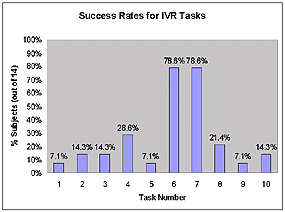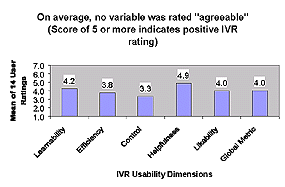|
|


IVR Solutions
This section of our technical library presents information and documentation relating to IVR Development and custom IVR software and products.
Business phone systems and toll free answering systems (generally 800 numbers and their equivalent) are very popular for service and sales organizations, allowing customers and prospects to call your organization anywhere in the country.
The PACER and WIZARD IVR System is just one of many DSC call center phone system features..
What is Interactive Voice Response?. An Interactive Voice Response (IVR) processes inbound phone calls, plays recorded messages including information extracted from databases and the internet, and potentially routes calls to either inhouse service agents or transfers the caller to an outside extension.
Contact DSC today. to learn more about our IVR services and IVR application development software.
Interactive Voice Response (IVR) Case Study:
Testing Your Telephone-Based e-Commerce Support
Page 4
Published in The Journal of Electronic Commerce, Volume 12, Number 2
| |
|
Below, we display
a chart of the performance results for easy comprehension. The chart
requires tabulation of results (see analysis, below).

Figure 1
Below, we display
subject comments for the two tasks failed by all participants but
one. Typically, subjects will not be clear on the source of their
confusion. The designer or usability specialist must evaluate each
comment for its design significance. Occasionally, a subject offered
no comment. We only present two examples here.
13 Failed
to "Change PIN" (Task 1 – Each bullet is from
a different fail subject.)
- I want to
update my card, not a service.
- Lots of
options and you would need it in writing. I'm not sure if the
menus are organized in related groups.
- Use fewer
words in sentences.
- Never found
words I could recognize as a similar term.
- Nothing
was clear. Too many options per number on the menu.
- PIN option
wasn't there. I was reaching my limits of patience.
- Was a little
confusing. Voice is overly sweet.
- He says
too much for each option.
- They assume
you know what the words talk about.
- There was
nothing specific for calling cards. I got lost.
- All the
talking seems to slur together.
- I don't
know where to change PIN.
13
Failed to "Review Fees" (Task 2 – Each bullet
is from a different fail subject.)
- Was easy
to do.
- Lots of
choices that had nothing to do with what I wanted to do.
- Would be
nice to have it (CSR option) on the main menu, but I can see why
they don't. Not so satisfied, a little frustrating.
- Got a little
lost in messages
- This was
easy task because I am becoming familiar
- Felt satisfied
with speed of getting an operator
- Going through
all options is a waste if I get a cs rep anyway.
- Opening
summary paragraph is annoying. It isn't helpful.
- I feel a
… frustration which is not the kind a business wants.
- What's the
point of the first menu ... you can't make any selection I wanted
a CS rep option on the first menu ...
- From the
Phones-R-Us side, it's OK that it took so long, but I get frustrated.
Recall
that we also collected statements regarding subjects "overall" impression.
Note in the following, that 6 subjects gave favorable statements.
They represent 44% of the subjects. Clearly, subjective impressions
can be misleading even in the face of severe usability problems.
6
Positive Post-test "Overall Impressions" (Each
bullet is from a different positive subject.)
- The system
is quite well designed
- It's good
- Relatively
usable menu that doesn't waste too much time
- Needs work.
Not bad though
- OK, but
needs more improvement
- Professional
corporate attempt to address a very complicated customer service
need – showed much work and effort, yet still room for improvement
8 Negative
Post-test "Overall Impressions" (Each bullet is
from a different negative subject.)
- A little
confusion – a lot offered, but not easily accessible
- Irrelevant,
I always ended up going to Customer Service, yet at the beginning
there was no option for Customer Service. The whole system couldn't
help on half the problems. I could just ask customer service at
the beginning and save time.
- A bit too
much information on the first menu. Could there be a simpler way
to get started?
- Slow. They're
more interested in mileage than phone service. Structure not completely
clear to find what is needed.
- Complicated
because main menu difficult to understand
- Took too
long to get anywhere
- Frustration
and dis-ease. Feeling of confusion and too much info at each stage.
- Very messy
menus. Unclear and confusing
|
| |
|
|
| Step
4. Collect Satisfaction Data |
|
After the test protocol, each subject filled out a satisfaction
questionnaire. (See next page.) Because the subject had just attempted
10 tasks, they could easily reflect on their subjective reactions.
The questionnaire represents five categories of satisfaction (discussed
below). We altered the original questionnaire (from other sources)
to accommodate IVR technology. |
| |
|
|
| Step
5. Analyze Performance Data |
|
In
this case, our goal is to show data indicating the extent of the
IVR problems. The results guide whether to make design changes or
not. Changes themselves presume expert knowledge of IVR design.
We represent this phase of the test with the following summary.
Tasks
1. Change PIN
2. Review fees per FTA
3. Learn MCI & Airmiles
4. Get code for Austria
5. Check overbilling
6. Check home rates
7. Add personal 800#
8. Learn France to Japan codes
9. Get credit for operator error
10. Get CSR
Overall
Results
- 10 tasks
X's 14 subjects = 140 test events
- 10 items
together averaged 27.1% passing rate
- 8 worst
items averaged 11.6% passing rate
- 40% of all
failures occur on the first menu item
We scored any
task as "fail" if the subject used a different IVR option than what
the designer intended. Often, a subject would get a CSR, thinking
it was a planned event. While the subject felt a positive outcome,
the IVR had failed. We also logged the level of menu at which the
subject failed to press the correct phone button. Notably, 40% of
all the failures occurred on the first menu item – a prime
target for improvement.
We indicate
that 140 "test events" constitute the body of evidence. In our data
analysis we learned our subjects only passed 27.1% – 38 of
the 140 events. Since 22 of those 38 passes occurred in only 2 of
the test items, we restated the results. We point out that the 8
worst items merited only 11.6% passing rate – only 16 out of
112 test events. Pretty expensive. The CSR staff has to work hard
to keep up with the callers asking for human help.
|
| |
|
|
| Step
6. Analyze Satisfaction Data |
|
We
grouped and averaged data from the satisfaction questionnaire as
follows. Where a question implied a negative response, the answer
was mathematically converted to match the meaning of the group description.
If you use the questionnaire, calculate the mean of the following
questions for each category.
a. Learnability:
1, 6, 12, 8, 20 (high priority)
b. Efficiency: 2, 4, 9, 11, 17, 21 (high priority)
c. Control: 3, 7, 8 (low priority)
d. Helpfulness: 10, 13, 15, 16 (low priority)
e. Likability: 5, 14, 19 (medium priority)
Global Metric:
.3a + .3b + .1c + .1d + .2e
We established
a yardstick of positive merit based on the nature of the scale.
Recall that the subjects selected a number from 1 to 7, with 4 representing
a neutral point. The next interval above the neutral 4 is 5. Therefore,
we set a score of 5 or above as indicating "positive" rating. (See
Figure 2)

Figure 2
|
Next
Page
[1]
[2]
[3]
[4]
[5]
|





